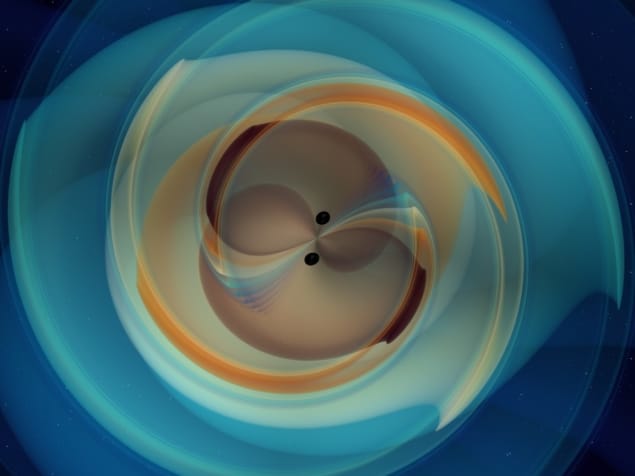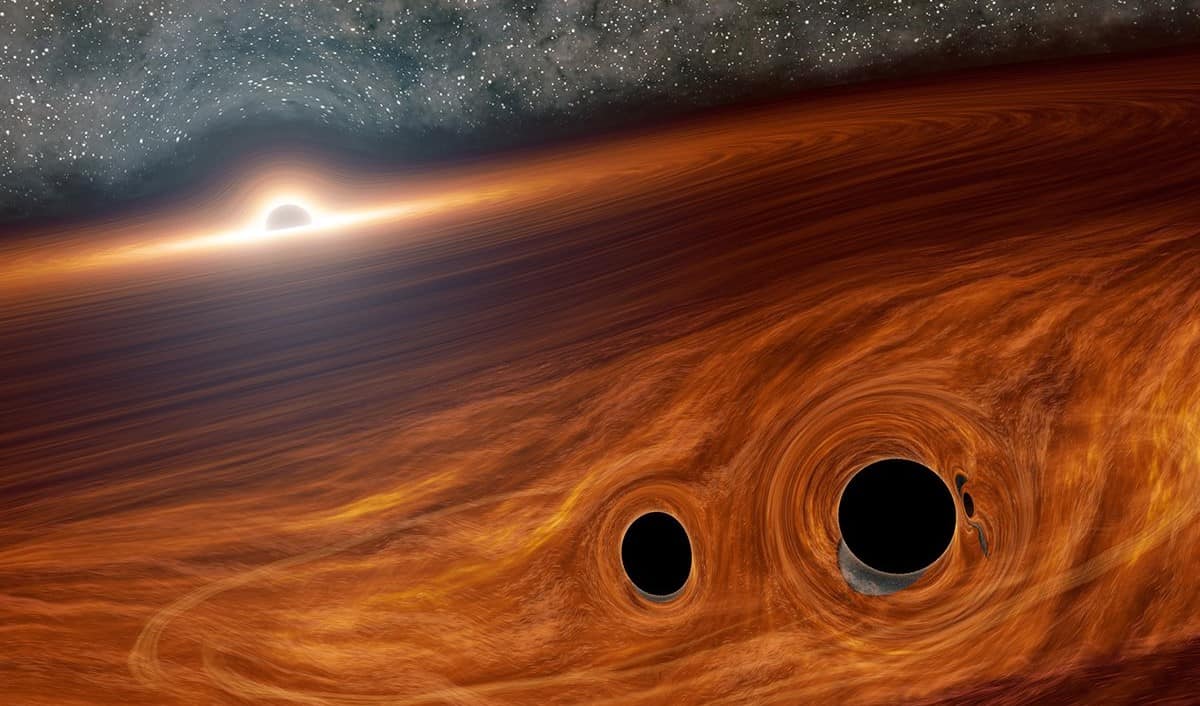
Gravitational waves from the most massive merger of two black holes ever seen have been detected by the LIGO–Virgo observatories. Dubbed GW190521, the event was spotted in May 2019 and involves the creation of a black hole with a mass of about 142 Suns. This is the first-ever intermediate-mass black hole to be observed using gravitational waves, with its mass falling between that of stellar-mass black holes and the supermassive black holes that dominate the centres of most large galaxies.
The initial pair of black holes are thought to have weighed in at 85 solar-masses and 66 solar-masses – making the heavier object the first black hole observed in the pair instability mass gap where black holes are not thought to form from collapsing stars.
The two black holes orbited each other, getting closer and closer together before they merged. In the last moments of this inspiral, the pair broadcast gravitational waves that were observed by the LIGO–Virgo detectors. These are three huge interferometers – two in the US and one in Italy.
A long time ago
Physics working on LIGO–Virgo have calculated that the merger took place 17 billion light-years from Earth when the universe was half the age it is today – making this one of the most distant mergers seen by LIGO–Virgo to date. Detecting the gravitational waves at such a large distance is possible because of the huge amount of energy they carried away from the merger – the mass-energy equivalent of eight Suns.
GW190521 is of particular interest to black hole experts because of the large masses of the three objects. Stellar mass black holes are created when a large star collapses under its own gravity, creating a huge supernova explosion that leaves behind a black hole.
Astrophysicists believe that stars of up to 130 solar masses will collapse in this way to create black holes with a maximum mass of about 65 solar masses. The same applies to stars heavier than about 200 solar masses, which will collapse to create black holes of greater than 120 solar masses.
Electron-positron pairs
However, stars in the 130-200 solar mass range experience an effect called pair instability as they collapse. Highly energetic photons within the star are converted into electron-positron pairs, which generate less outward pressure than photons. This causes a rapid gravitational collapse of the star and an extremely violent explosion that leaves no black hole behind.
As a result, astrophysicists believe that there should be a gap in the mass spectrum of black holes ranging from about 65-120 solar masses. Therefore, it looks like one – or possibly both – of the GW190521 progenitor black holes lies in this gap, leading astrophysicists to speculate on their possible origins. One possibility is that the progenitor black holes may themselves have been formed in black hole mergers.

Did a black-hole merger create a flash in a distant quasar?
Although a black hole merger is the most likely source of GW190521, the way in which the event was detected opens the door to other intriguing possibilities. LIGO–Virgo looks for signs of gravitational waves in two different ways. One method involves looking for signals that resemble the gravitational waves that astrophysicists expect to be given off by merging black holes or neutron stars. The other involves looking for anything out of the ordinary – and is called a “burst” search.
In the case of GW190521, a burst search was slightly better at identifying the signal, which opens the enticing possibility that the source of the signal is not a distant black hole merger but rather the collapse of a star in the Milky Way. Another possibility, says the LIGO–Virgo team, is that the signal was created by a cosmic string that was produced just after the inflationary epoch of the early universe.
Earlier this year an international team of astronomers suggested that GW190521 may have been accompanied by a flare of light from a distant quasar, making it the first gravitational-wave signal from merging black holes to have an electromagnetic counterpart. However, more recent work suggests that the quasar is not in the same part of the sky as GW190521.
The researchers report the detection of GW190521 in Physical Review Letters and speculate on its possible origins in The Astrophysical Journal Letters.
- In the video below, Nergis Mavalvala of the Massachusetts Institute of Technology explains how LIGO detects gravitational waves.
